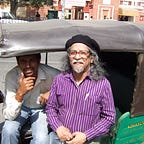Vision and Colour (Part Two)
How the blind “see” colour?
It was the view of many thinkers and philosophers that if one was deprived of vision and hearing, then one would not understand the world. David Hume put forward the view that if the senses could not be stimulated, “by individual energies”, then no ideas could be formed. This view was sadly held by many. Happily, this belief has been proved to be wrong since, but scientists are far from understanding how the blind perceive things. What do they make of colour?
There are many blind artists who have achieved prominence in the field of painting. Bramblitt is one of them. His paintings sell all over the world, some
going for $50,000. His Einstein is an example. Saggy Mann who died in 2015 was a blind artist who was recognised as one of the best painter in the United
Kingdom. There are many more than one would think. However, they were all born sighted.
Esref Armagan, however, was blind from birth! Yet he is an accomplished painter, possibly the best known artist from Turkey. He has a grasp of not only
colour, but shades and perspective as well. Harvard, readily acknowledged his genius and invited him for a brain and eye scan. One of their most interesting findings was that the visual cortex of his brain, which is basically dark in the visually impaired, lit up when the painter touched an object and began
drawing. He says that when his fingertips moves across something red, he feels a certain warmth. One can interpolate and get an idea of how he perceives other colours.
He has developed his own techniques in order to successfully depict a variety of topics. First he forms the total picture in his head, complete with the colours he will use. He uses only 5 colours plus black and white and mixes them to represent the image he has in mind. From then on it is a case of careful concentration to complete a picture to his satisfaction.
How did he get there? As a child he never stopped asking questions about the physical and visual world and built strong memories of what his father told him. Armagan senior had an engineering workshop, and the child spent a lot of time there, learning about his surrounding environment. His father would guide his blind son’s hand over the engraved lines and describe what he saw. The young artist then practised making lines to represent visual edges and shading, which he showed to family members, and he would listen carefully to their comments, and use them to modify his perception.
Having mastered visual ideas such as edges and shade, the teenage Armagan began drawing in colour, and continued to seek comments and feedback from those around him.
